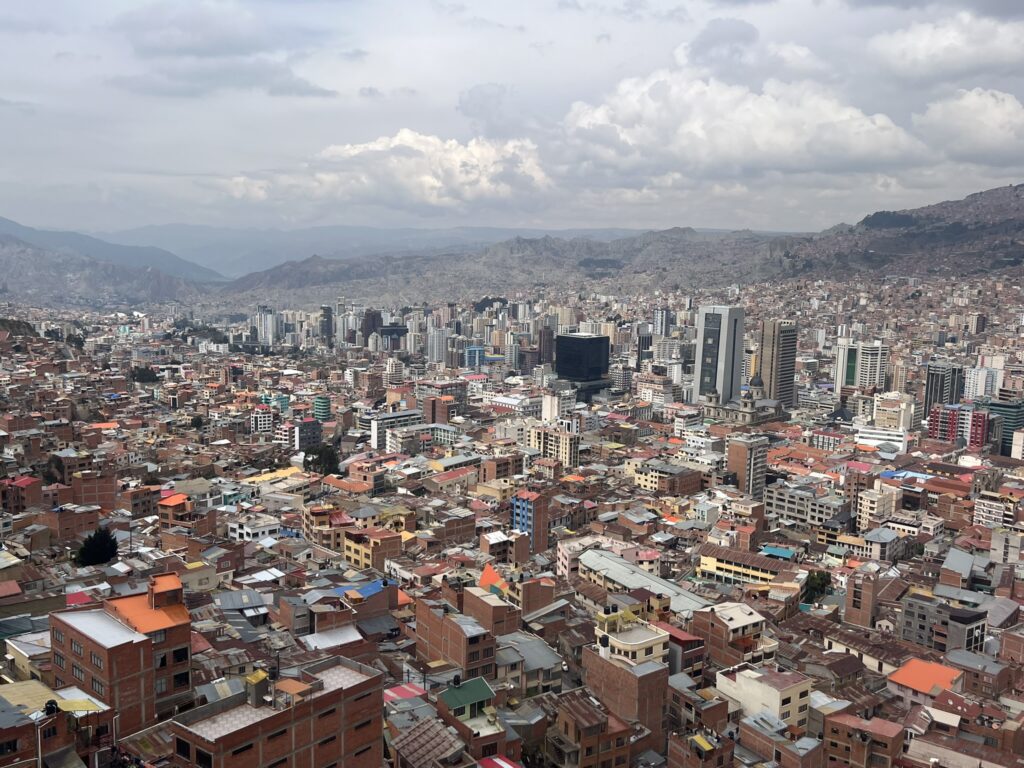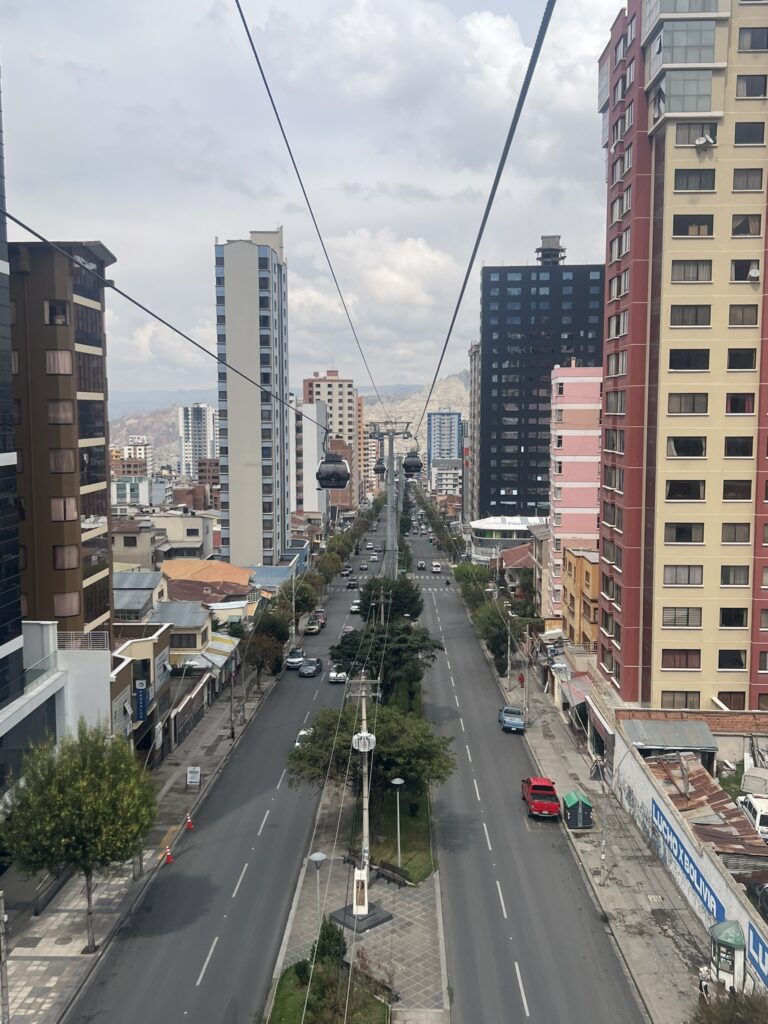The La Paz-El Alto metro area in Bolivia, regarded as the highest in the world, has an average elevation of nearly 13,000 feet. We used the innovative cable car systems to explore the area while spending time in La Paz.
Best Thing I Ate This Week
Fricase at Popular Cocina Boliviana in La Paz
Popular Cocina Boliviana is located on the second floor of a courtyard in the center of La Paz, Bolivia. When researching great places to eat in the city, this continually came up and it even received recognition as one of the best restaurants in Latin America. The restaurant is only open for lunch Monday to Saturday and given its popularity, it is very difficult to secure a table.

Luckily for us, after completing a walking tour in La Paz’s historic center, another couple we met had a reservation and invited us to join them for lunch. As we walked up to the restaurant, there was a line of people waiting for no-shows to try and get a coveted lunch table. The server showed us to our table and reviewed the 3-course menu as well as the fresh juices to accompany the meal. We placed our choices for an appetizer, main, and dessert as the packed restaurant bustled with happy diners.


Most dishes on the weekly rotating menu were classic Bolivian items presented in a contemporary way. For example, the Tucamana was plated in a cone with a beautiful garnish that made it look like a bouquet. My main dish, the Fricase, was a take on pork soup that is very traditional in Bolivia but was inverted in its preparation. Instead of being in a broth, the pork was presented in the middle of the plate and a sauce was added table-side on top of the meat. It was an incredible presentation, a delicious flavor, and an overall wonderful meal with great company.
An Interesting Fact I Learned
Tiwanaku was a technologically advanced Pre-Incan civilization
Tiwanaku is located near the southeastern shore of Lake Titicaca and is about a 90-minute drive from La Paz. The current-day town of Tiwanaku contains ruins from the Pre-Incan civilization, also named Tiwanaku, that inhabited the area from as early as 1,200 B.C. Tour companies in La Paz offer a day trip that departs the city around 8:30 am and returns at 3:30 pm. Besides providing transportation, a certified guide shares information at the museums and archaeological sites in Tiwanaku.

While the Inca Empire is the most known civilization in South America, Tiwanaku pre-dated their rise by hundreds of years (400-900 A.D. was the peak of power) and had technological capabilities that still baffle modern-day archaeologists. The Tiwanaku civilization suddenly disappeared in the 12th century, and, unfortunately, when the Spanish came to the area, they destroyed or repurposed many of the ruins they found. Today archaeologists are working to uncover more at the sites and are trying to piece together the puzzle about this mysterious civilization. Our guide let us know that the day prior to our visit a gold mask had been found and it was currently undergoing testing to learn more about its purpose.


While walking among the ruins, seeing the artifacts in the museums, and learning more from our guide it was remarkable the impressive accomplishments achieved so long ago. Somehow, the ancient civilization was able to cut incredibly strong stone with such precision and without markings that even modern techniques cannot replicate it. Additionally, they moved full slabs of stone from miles away weighing immense tons. Further, they built structures that aligned with stars and constellations, in particular the Andean Cross. Above all, they created agricultural structures that manipulated the weather and may have been the first to cultivate potatoes.

Some people credit all of these achievements to extraterrestrial beings, and, among the ruins, there is a mysterious carving of a face that some believe to be a representation of an alien. For me, I am excited to continue to follow the discoveries of archaeologists to learn more about the facts and myths of the future.
My Travel Tip of the Week
Be careful about the food you eat in Laz Paz and Bolivia
I consider myself a pretty adventurous eater at home and while traveling. When going to new destinations, one of my favorite ways to learn more about the local culture is to try the food and drinks that are most popular with the people who live there. Without any dietary restrictions, it is easy for me to sample the best dishes at restaurants around the world wherever I go.

Over the years I have learned that various countries have different sanitary standards and to be particularly careful in those that have water contamination issues. Normally, I ask locals if there is anything that they do not eat, such as street food or uncooked vegetables, which helps me avoid eating riskier items that might cause stomach issues.


After spending a lot of time in Argentina and Chile, I had become accustomed to eating everything without issues and assumed the same would be true in Bolivia. While in La Paz, I ate a combination of street food, sushi, raw fruit, raw vegetables, and new meat on the same day. Soon after, I developed pretty severe conditions that persisted for numerous days and required a trip to the doctor. The doctor let me know that I contracted Salmonella, which is very common for travelers and locals in La Paz and Bolivia. Their advice was to avoid any more street meat, uncooked fruit/vegetables, and to only eat at restaurants in El Centro, Sopocachi, and Distrito Sur.


On your next trip to Bolivia, I would recommend following the same advice given to me by the doctor as many other travelers that we met while visiting La Paz developed similar conditions or knew of someone in their group who experienced these issues. This experience also served as a reminder for me to not be complacent and always check with locals to confirm their dining habits so that I can better reduce my risk for digestive issues.
My Additional Anecdote This Week
Mi Teleferico is a Wonderful Experience In La Paz, Bolivia to See the City
Mi Teleferico is an extensive cable car system that connects neighborhoods in La Paz and the cities of La Paz and El Alto. The first phase of the transportation system was completed in 2014, and, although other cities like Medellin, Colombia also have a cable car system, La Paz is the only city that leverages cable cars as its primary mass transit system for navigating the metropolitan area. Since 2014, Mi Telefrico has continued to grow and now includes 10 lines and nearly 30 stations around the city. Besides being a practical way to navigate La Paz, the views of the various lines are spectacular and marketed as a top tourist attraction for visitors to the city.

Whenever we visit new cities, we enjoy using the public transportation systems. Since Mi Telefrico was rated as a top attraction, on our first day of exploration we prioritized riding around the city in a circle to get incredible views of La Paz from all directions. Our route started with Linea Amarilla and then proceeded to Plateada, Roja, Naranja, and Blanca before completing our trip on Linea Celeste. On Linea Amarilla and Linea Roja, there were incredible views of La Paz city sprawled below and Huayana Potosi towering in the distance. Linea Plateada passed over El Alto and since it was Thursday we could see Latin America’s largest market, Feria 16 de Julio, from above. Linea Blanca cut through the high rises of the business district, Linea Naranja had highlight views of the Centro, and Linea Celeste traveled right to the heart of the city.


It is hard to pick a favorite line, and besides our circle around the city, we used Mi Teleferico daily to visit different areas in La Paz. One of the most remarkable experiences on Mi Teleférico was taking Linea Verde to Distrito Sur. On this journey, we saw a whole different side of La Paz with mansions lining the hills, high rises containing the most expensive apartments, and top restaurants located in the valley below. In addition to being practical to get around and having amazing views of the city, the cable cars themselves were spotless and the stations were beautifully maintained. It was clear the city had a lot of pride in the transit system, and, after visiting Laz Paz, I will always remember the wonderful experience on Mi Teleferico.


